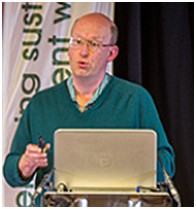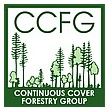Presentation – Current Extent, Motivation and Status of Continuous Cover Forestry Adoption in Britain: a Review
Speaker:

Scott McG Wilson
Consultant Forester and Forest Ecologist Aberdeen
Biography:
Following completion of an MSc in Resource Management from the University of Edinburgh (1994) I continued there, undertaking a PhD in Forest Soils and Ecology, working on development of the Forestry Commission’s Ecological Site Classification (ESC). Since 1998 I have practised as an independent consultant forester and forest ecologist, based in Aberdeen (Chartered Forester since 2001). I have worked on a wide range of surveying, consultancy, policy advice and published authorship projects covering native woodland ecology, garden/ landscape history, hardwood tree improvement, alternative conifer species, silvicultural systems and ecosystem services. My professional interests are developing towards integrated rural estate management.
Synopsis of Presentation:
A previous review of alternative silvicultural systems (ATC/ CCF) adoption in Britain was by Hart (1995) (FC Bulletin 115). More recently there has been promotion of wider adoption and ramification of proposed advantages and techniques. A fresh review was conducted by the present author in 2012-13, employing desk study, technical consultation and field visits. Illustrated case-studies of successful ATC adoption were developed. While “classical”, “mature” or “well-developed” ATC still applies to only 2-3% of British woodland, larger areas across all ownerships are now subject to less mature / formalised inception of ATC by thinning responding to natural regeneration of crop species. Emerging objectives include reduced restocking outlay, gradual PAWS restoration, species diversification and increased resilience to climatic and pathogenic perturbations. Continued British expansion of ATC is constrained to some extent by fundamental site factors, principally in exposed upland areas. However operational constraints remain centred on shortages of ATC-relevant equipment, skills and expertise in the British forestry sector as compared to the Continental situation and weakly developed / resourced networks of quantified research, demonstration and monitoring sites. Enabling actions required included increased public-sector funding on a strategic level and re-invigorated participation by academic, private-sector and “citizen-science” actors at a tactical level.
Conference Resource:
- Download/View Scott McG Wilson’s Presentation [PDF, 13.6 MB]
Websites and References:
- www.scottishforestrytrust.org.uk
- Wilson, S.McG. (2014, in press) Living with climate change: Mediterranean trees and agroforestry in Britain? Quarterly Journal of Forestry 108(2): xxx-xxx.
- Wilson, S.McG. (2013) Adoption of alternative silvicultural systems in Great Britain: a review. Quarterly Journal of Forestry 107(4): 279-293.
- Wilson, S.McG. (2012) Retaining timber potential after PAWS restoration. Quarterly Journal of Forestry 106(2): 105-118.
- Wilson, S.McG. (2011) Using Alternative Conifer Species for Productive Forestry in Scotland. Edinburgh: Forestry Commission Scotland.
- Wilson, S.McG. (2010) Minor conifers in Britain – potential for silviculture and timber utilisation. Quarterly Journal of Forestry 104(1): 29-42.


